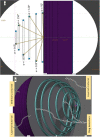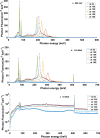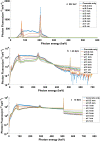Monte Carlo simulation of photons backscattering from various thicknesses of lead layered over concrete for energies 0.25-20 MeV using FLUKA code
- PMID: 34526527
- PMCID: PMC8443695
- DOI: 10.1038/s41598-021-96026-y
Monte Carlo simulation of photons backscattering from various thicknesses of lead layered over concrete for energies 0.25-20 MeV using FLUKA code
Abstract
There is an increased interest in determining the photon reflection coefficient for layered systems consisting of lead (Pb) and concrete. The generation of accurate reflection coefficient data has implications for many fields, especially radiation protection, industry, and radiotherapy room design. Therefore, this study aims to calculate the reflection coefficients of photons for various lead thicknesses covering the concrete. This new data for lead, layered over concrete, supports various applications, such as an improved design of the mazes used for radiotherapy rooms, which helps to reduce cost and space requirements. The FLUKA Monte Carlo code was used to calculate photon reflection coefficients for a concrete wall with different energies. The reflection coefficient was also calculated for a concrete wall covered by varying thicknesses of lead to study the effect of lining this metal on the concrete wall. The concrete's reflection coefficient data were compared to internationally published data and showed that Monte Carlo calculations differed significantly from some of the extrapolated data. The absorbed dose of backscattered photons for various thicknesses of lead covering the ordinary concrete has been tabulated as a function of the reflection angle. Also, the reflection coefficient as a function of the Pb thicknesses covering the ordinary concrete has been figured to study the dose reduction factor. The generation of accurate data for reflection coefficients is vital for many fields, especially for radiation protection and radiotherapy room design. The new data have been presented for lead layered over concrete in various applications, such as an improvement in the design of the mazes used for radiotherapy rooms, thereby reducing the cost and space requirements. In addition, the Monte Carlo method enables calculating the energy distribution of reflected photons, and these were shown for a range of angles.
© 2021. The Author(s).
Conflict of interest statement
The authors declare no competing interests.
Figures







 represents 0.2 mm Pb,
represents 0.2 mm Pb,  represents 0.5 mm Pb,
represents 0.5 mm Pb,  represents 1 mm Pb,
represents 1 mm Pb,  represents 2 mm Pb,
represents 2 mm Pb,  represents 3 mm Pb, and
represents 3 mm Pb, and  represents 6 mm Pb.
represents 6 mm Pb.References
-
- Al-Affan IM, Hugtenburg RP, Bari DS, Al-Saleh WM, Piliero M, Evans S, et al. Dose reduction of scattered photons from concrete walls lined with lead: Implications for improvement in design of megavoltage radiation therapy facility mazes. Med. Phys. 2015;42(2):606–614. doi: 10.1118/1.4905100. - DOI - PubMed
-
- Faw RE, Shultis JK. Radiological Assessment: Sources and Doses. American Nuclear Society; 1999.
-
- Al-Affan, I. A. M., Smith, C. W., Morgan, H. M. & Llillicrap, S. C. Dose rate and energy distributions of x-rays from a linear accelerator at the maze entrance of a radiotherapy room by measurement and Monte Carlo simulation. Radiat. Prot. Dosim.78, 273–277 (1998).
LinkOut - more resources
Full Text Sources

